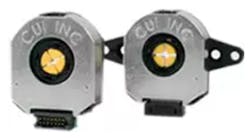Capacitive Sensing: A Paradigm Shift for Encoders (.PDF Download)
Encoders are a vital component in many applications that require motion control and feedback information. Whether a system’s requirement is speed, direction, or distance, an encoder produces control information about the system’s motion.
As the direction of electronics strives toward higher resolution, ruggedness, and lower costs, the encoder sensing mechanism is also improving in these areas. Traditionally, the encoder’s sensing mechanism has been optical or magnetic. But there’s a new player in town: the capacitive electric encoder. We’re going to talk about this new player and how it measures up to the encoding environment’s accuracy and ruggedness requirements.
1. Different encoder types developed by CUI. (Courtesy of Digi-Key)
Encoder Classes
An encoder is a device that converts information from one format to another. In this article, the encoder is a motion detector with an electrical drive element. There are two different classes of electrical encoders: linear and rotary.
A linear class measures motion along a straight path, providing position, speed, and direction. This encoder has a sensor, transducer, and a location reader. An analog or digital output signal relays the encoder’s position to the system’s receiver. The encoder reads the information and identifies the encoder’s position. The encoder can provide speed or velocity data over time and with two sensors, the determination of direction is possible.
A rotary class, also called a shaft encoder, is a must-have in a hobby shop for driving motors. This device activates motors and measures rotational motion or angular position. The rotary encoder also has a sensor, transducer, and location reader. The reader relates the current position of the shaft to provide angular data to the user. The encoder also can provide speed or velocity data over time and with two sensors, it’s possible to determine the encoder’s direction.
Two Different Encoder Categories
The encoder output governs the category of the encoder’s category: incremental or absolute. An incremental encoder provides speed and distance feedback of any linear and rotary system. This category of the encoder device generates a plus train or a square wave to determine position and speed. Typically, the output signal is either zero or the supply voltage.


